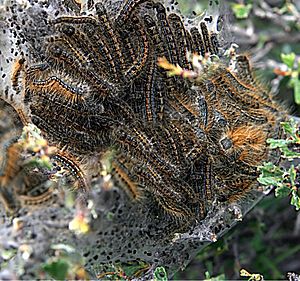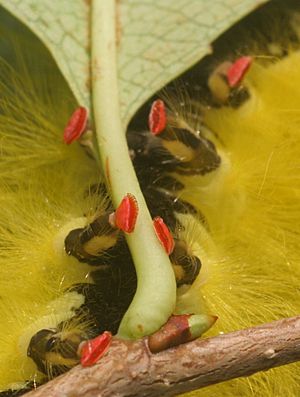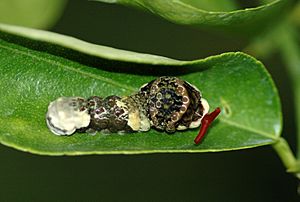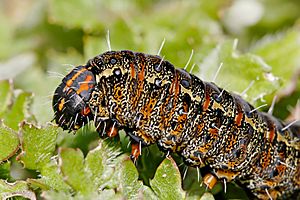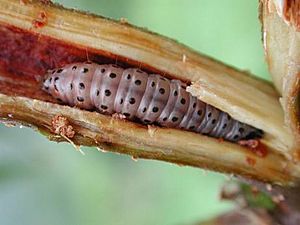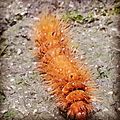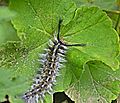Caterpillar facts for kids
A caterpillar is the young form of a butterfly or moth. It hatches from an egg and is a type of larva. After growing, a caterpillar changes into a pupa (also called a chrysalis). Later, the pupa transforms into an adult butterfly or moth.
Caterpillars usually have three pairs of small legs near their head. They also have up to five pairs of soft, fleshy "false legs" at the back.
You can often find caterpillars eating leaves. Some also live inside plant stems, branches, roots, or even dead wood.
Most caterpillars are green or brown and don't have much hair. However, many types are very hairy and have bright colors. Some caterpillars are considered pests because they eat plants, carpets, wool, or stored food.
Caterpillars are an important food source for birds and other invertebrates. Many species also help break down dead plants and animals.

Contents
What's in a Name?
The word "caterpillar" first appeared in the early 1500s. It comes from old French words that mean "hairy cat." This name likely came from how some caterpillars look, with their furry bodies.
Body Parts
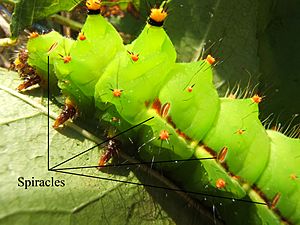
Most caterpillars have long, tube-shaped bodies divided into many parts. They have three pairs of true legs on the front part of their body. They also have up to four pairs of soft prolegs on their middle sections. Often, there's one more pair of prolegs at the very end of their body.
Like all insects, caterpillars breathe through tiny holes called spiracles. These holes are along the sides of their body. A few types of caterpillars, like some from the Pyralidae family, live in water. They have gills that help them breathe underwater.
Caterpillars have many muscles, about 4,000 in total! Humans, for comparison, have around 629 muscles. Caterpillars move by squeezing muscles in their back parts. This pushes blood forward, making their front parts stretch out.
How Caterpillars Sense the World
Caterpillars don't see very well. They have six tiny eye spots, called 'stemmata', on each side of their head. These eyes can probably see shapes but not clear images. Caterpillars often move their heads from side to side. This helps them figure out how far away things are, especially plants they want to eat. They use their short antennae to find food.
Some caterpillars can feel vibrations. For example, hook-tip moth caterpillars make sounds by scraping leaves. They do this to protect their silk nests from other moths. They feel the vibrations through the plant. Tent caterpillars can also feel vibrations from the wings of their enemies.
Different Kinds of Caterpillars
Geometrid caterpillars are also known as inchworms or loopers. They get their name from how they move. They seem to "measure the earth" as they walk. This is because they have very few prolegs, only at the very end of their body.
Caterpillars have soft bodies that can grow very fast. They shed their tough outer skin, called a head capsule, several times as they get bigger. Caterpillars have strong, sharp mandibles (jaws) for chewing leaves. Behind their mandibles are spinnerets, which they use to make silk.
Some young Hymenoptera insects (like sawflies, which are related to bees and wasps) look like caterpillars. You can tell them apart because sawfly larvae have prolegs on every part of their abdomen. True caterpillars have tiny hooks, called crochets, on their prolegs, which sawfly larvae don't have. Also, caterpillars have an upside-down Y-shaped line on the front of their head.
How Caterpillars Protect Themselves
Many animals like to eat caterpillars because they are full of protein. Because of this, caterpillars have developed many ways to protect themselves.
Looking Like Something Else
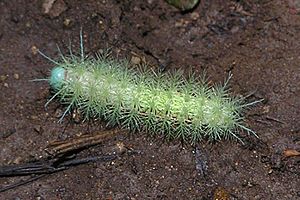
Many caterpillars use camouflage to blend in with their surroundings. They might be the same color as the plants they eat. Some even look like parts of plants, such as thorns. Their size can vary a lot, from tiny (1 mm) to quite large (about 3 inches). Some caterpillars look like bird droppings to avoid being eaten. Many live hidden inside silk nests or rolled-up leaves.
Caterpillars can also have more active ways to defend themselves. Some have spiny bristles or long, fine hairs. These hairs have tips that can break off and irritate skin or other soft body parts. However, some birds, like cuckoos, can eat even the hairiest caterpillars. The most dangerous hairs are those connected to venom glands. These are called urticating hairs. Some caterpillars, like the Lonomia silk moth from South America, have very strong venom. This venom can make people very sick. Most urticating hairs cause mild irritation or skin rashes.
Plants have developed poisons to protect themselves from insects. But some caterpillars have learned to eat these toxic plants. Not only are they not harmed by the poison, but they also store it in their bodies. This makes them very toxic to animals that try to eat them. These chemicals stay with them even when they become adult butterflies or moths. Toxic caterpillars, like the Cinnabar moth and Monarch butterfly, often have bright stripes or colors like black, red, and yellow. These are "danger colors" that warn predators (this is called aposematism). Any animal that tries to eat one of these caterpillars will learn to avoid them in the future.
Some caterpillars spit out acidic digestive juices at enemies. Many swallowtail caterpillars have special glands called osmeteria. These glands pop out and release bad smells when the caterpillar is in danger.
Caterpillars can also escape predators by dropping off branches using a silk line when they are disturbed.
Some caterpillars get protection by living with ants. Lycaenid butterflies are well-known for this. They communicate with the ants using vibrations and chemicals. In return, they often give the ants a sugary liquid as a reward.
Some caterpillars live in large groups. Being in a group is thought to help protect them from parasites and predators. Large groups make their warning colors more obvious. Individuals in a group might also spit up together or put on a group display to scare off enemies.
How Caterpillars Live
Caterpillars are often called "eating machines" because they eat leaves very quickly. Most types shed their skin four or five times as they grow. After this, they change into their pupa stage. Caterpillars grow incredibly fast. For example, a tobacco hornworm can become ten thousand times heavier in less than twenty days! They can eat so much because they have a special part of their gut that quickly moves nutrients into their body.
Most caterpillars only eat plants (they are herbivorous). Many eat only one specific type of plant. Others can eat many different kinds of plants. A few, like the clothes moth, eat dead things. Most predatory caterpillars eat the eggs of other insects, aphids, or ant larvae. Some even eat other caterpillars. A few are parasites that live on cicadas or leaf hoppers. Some caterpillars in Hawaii even use silk traps to catch snails!
Many caterpillars are active at night. For example, "cutworms" (from the Noctuidae family) hide at the base of plants during the day and only feed at night. Other caterpillars, like gypsy moth larvae, might change when they eat. Younger caterpillars or those in crowded areas might eat more during the day.
Caterpillars and People
Caterpillars can cause a lot of damage, mostly by eating leaves. The cotton bollworm causes huge losses to cotton crops. Other types eat food crops. People try to control caterpillars using pesticides, biological control (using natural enemies), and farming methods. However, many caterpillars have become resistant to pesticides. Scientists also use special bacteria, like Bacillus thuringiensis, which produce toxins that harm caterpillars. These toxins can be sprayed or even put into the plants themselves. But over time, caterpillars can develop ways to resist these methods.
Plants also develop ways to protect themselves from caterpillars. They can produce natural chemicals that are toxic to caterpillars or grow physical barriers like hairs. Scientists also try to breed plants that are naturally resistant to caterpillars.
Some caterpillars are very useful to people. The silk industry, which makes silk fabric, relies on the silkworm caterpillar.
Caterpillars and Your Health
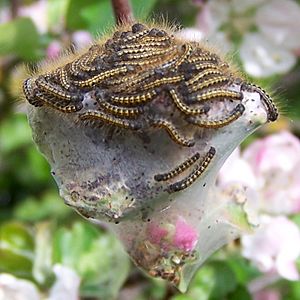
Caterpillar hairs can sometimes cause health problems for humans. The hairs of some caterpillars contain venom. About 12 families of moths or butterflies around the world have caterpillars that can cause serious health issues. These can range from skin rashes and asthma to more severe problems. Skin rashes are the most common issue.
Caterpillar hairs can also cause eye problems. The sharp, barbed ends of the hairs can get stuck in soft tissues like the eyes or other moist body parts. Once they are in, they can be hard to remove. They might even move deeper into the tissue, making the problem worse.
This can be a particular issue indoors. The tiny hairs can easily enter buildings through air vents. They can build up inside because they are so small and hard to get rid of. This increases the chance of people coming into contact with them indoors.
Images for kids
-
A monarch butterfly (Danaus plexippus) caterpillar feeding on an unopened seed pod of swamp milkweed
-
Caterpillar cocoon on a pine tree branch.
-
Larvae of Craesus septentrionalis, a sawfly showing six pairs of prolegs.
-
Eogeometer vadens, the earliest known geometrid moth caterpillar found in Baltic amber
-
The saddleback caterpillar has urticating hair and aposematic colouring.
-
A gypsy moth caterpillar
-
William Blake's illustration of a caterpillar overlooking a child from his illustrated book For Children The Gates of Paradise.
-
A 1907 illustrations by Arthur Rackham of the Caterpillar talking to Alice in Alice's Adventures in Wonderland
-
Caterpillar of the spurge hawk-moth, near Binn, Valais, Switzerland at c. 2 km altitude.
-
Phalaenoides glycinae (Australian grapevine moth) feeding on a grapevine.
-
Caterpillar of the emperor gum moth.
-
Ant tending a lycaenid caterpillar.
-
Forest tent caterpillar (Malacosoma disstria)
-
Camouflage: apparently with eight eyes, only two of them are real. Photo in a eucalyptus tree, São Paulo, Brazil
-
Caterpillar of the Polyphemus moth (Antheraea polyphemus), Virginia, United States
-
Prepupa of cabbage looper in its cocoon
-
Locomotion of a small Geometrid caterpillar.
See also
 In Spanish: Oruga (larva) para niños
In Spanish: Oruga (larva) para niños


